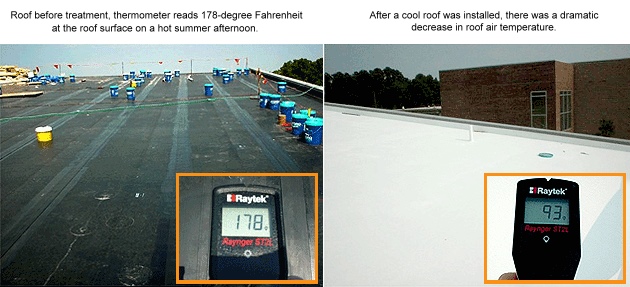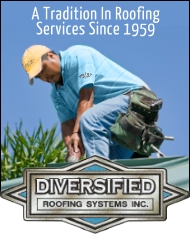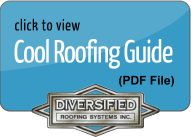Cool Roofing Benefits
People who live in tropical climates usually wear light-colored or white clothing to help keep themselves cool. They know that light colors reflect heat and sunlight; whereas dark colors absorb heat and light. Buildings are similar to people. If you have a dark-colored roof, your building will be hotter than if it had a light-colored roof.
Cool Roofs are roofs consisting of materials that very effectively reflect the sun’s energy from the roof surface. Cool materials for low-slope roofs are mainly bright white in color, although non-white colors are starting to become available for sloped roof applications. Cool Roofs must also have high emissivity, allowing them to emit infrared energy. Unfortunately bare metals and metallic coatings tend to have low emissivity and are not considered cool materials.
Cool roofs can reduce the roof surface temperature by up to 100 degrees Fahrenheit, thereby reducing the heat transferred into the building below. This helps to reduce energy costs (by keeping attics and ducts cooler), improve occupant comfort, cut maintenance costs, increase the life cycle of the roof, and reduce urban heat islands along with associated smog.
Some benefits of Cool Roofs:
- Save on annual electricity bills by reducing summer air conditioning costs.
- Save peak electricity demand costs if you have time-of-use metering.
- Reduce roof maintenance and replacement expenses by extending roof life.
- Increase indoor comfort in summer by reduction of infrared conversion from visible light.
- Reduce the “heat island effect” in cities and suburbs.
- Reduce air pollution and smog formation.
- Reduce roofing waste added to landfills.
.
.
FAQ
What is a cool roof?
Cool roofs are highly reflective and emissive materials that stay 50 to 60 degrees F cooler in the summer sun, thereby reducing energy costs, improving occupant comfort, cutting maintenance costs, increasing the life cycle of the roof, and contributing to the reduction of urban heat islands and associated smog.
What kind of roofing products are available for commercial and residential applications?
Products for low-slope roofs, found on commercial and industrial buildings, fall into two categories – single-ply materials and coatings. Single-ply materials are large sheets of pre-made roofing that are mechanically fastened over the existing roof and sealed at the Seams. Coatings are applied using rollers, sprays, or brushes, over an existing clean, leak-free roof surface.
Products for sloped roofs, usually found on residences, are currently available in clay, or concrete tiles. These products stay cooler by the use of special pigments that reflect the sun’s infrared heat. Lower priced shingles or coated metal roofing products are not yet available in “cool” versions.
Visit the ENERGY STAR® Website for a list of cool roof products and manufacturers. www.energystar.gov
How cool is a cool roof?
During the summer, a typical dark roof is 150 to 190 degrees Fahrenheit at peak, while cool roofs peak at 100 to 120 degrees Fahrenheit.
Do cool roofs cost more than conventional roofs?
Initial material costs are comparable with traditional roofing materials – some cool products cost less than traditional materials, some cost up to 20% more. Cool protective coatings can be reapplied repeatedly every 10 to 15 years and reduce, if not eliminate the need for expensive roof tear-offs. Combining these maintenance savings with an average 20 percent savings on air conditioning costs make cool roofing a better bargain over the long term.
Are rebates available for cool roofs?
In addition to energy and life cycle savings, rebates are available from some local utility companies for cool roofing. For more information on cool roof rebates, visit the Flex Your Power website at: www.fypower.org
Where do I find cool roofs Title 24 Building Energy Efficiency Standards?
Cool roofs are included as a performance option in Title 24. Refer to Section 10-113 for information on certification and labeling requirements for reflectance and emittance of cool roof products. For the prescriptive compliance approach in the energy efficiency standards, view section 118 of Title 24. Sections 141, 142, and 151(b) outline the performance approach.
Are cool roofs required for residential or nonresidential energy efficiency standards?
No, they are not required, but there are energy credits available to those who use the compliance options in the performance approach.
What specifications does a roof need to meet to be considered for credit under the Title 24 Standards?
Commercial and residential products must meet the following specifications according to the ASTM standards outlined below:





